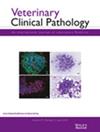Association of leukergy (in vitro leukocyte aggregation) with systemic inflammation in dogs and cats (2017–2022)
Abstract
Background
Leukergy is the phenomenon of aggregation of leukocytes on a peripheral blood film, and in humans, it is used as an indicator of systemic inflammation and infection.
Objectives
To assess the association of leukergy on blood film examination with biochemical and clinical evidence of systemic inflammation, infection, neoplasia, or specific organ system disease.
Methods
A case–control study using retrospective analysis (2017–2022) identified all canine and feline patients that had been presented to an academic referral center with a finding of leukergy on peripheral blood film and an equal number of species-matched controls.
Results
A total of 127 cases (canine n = 44, feline n = 83) were identified, as well as 127 controls. Feline samples were 7.6× more likely to exhibit leukergy (0.019%) than canine (0.0025%). A positive association was noted between leukergy and higher globulin concentrations in dogs (marginal difference 0.5 mg/dL, P = .016) and cats (marginal difference 0.67 mg/dL, P = <.001). Cats with leukergy had higher WBC counts and were less likely to be diagnosed with cardiac or urinary tract disease than controls. Dogs with leukergy had lower WBC counts and were more likely to be febrile but were less likely to have urinary tract disease than controls. No association was found with neutrophil toxic change or band forms, systemic antimicrobial therapy, or signalment.
Conclusions
We conclude that there is a positive association between increased globulin concentrations and leukergy and inconsistent associations between leukergy and other markers of inflammation or infection. Leukergy is rare overall but markedly more common in cats than dogs.

 求助内容:
求助内容: 应助结果提醒方式:
应助结果提醒方式:


